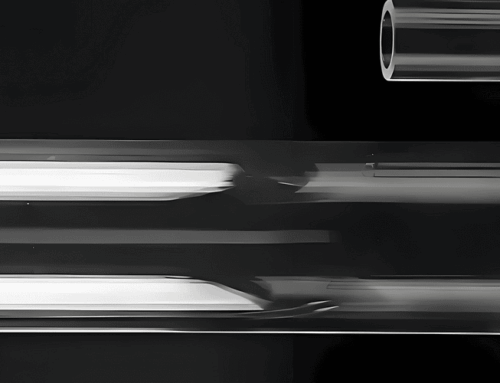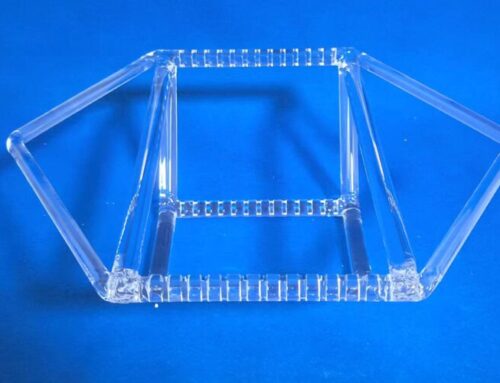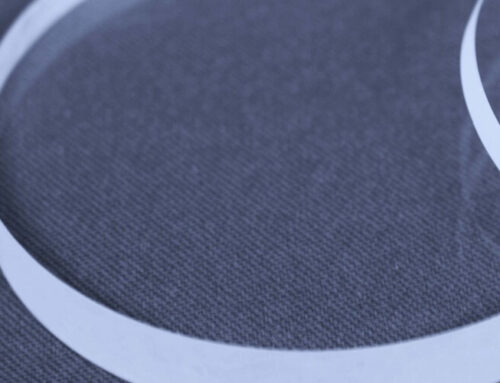The refractive index of quartz glass is affected by many factors, including its composition, structure and manufacturing process. The following is a discussion of the factors which have an effect on the refractive index of quartz glass and its importance to practical applications for quartz glass.
Composition
The refractive index of quartz glass is closely related to its composition. In quartz glass, the fundamental structural unit is the silicon-oxygen tetrahedron, characterized by a silicon atom at the center of tetrahedron and four oxygen atoms positioned at its four vertices. These silicon-oxygen tetrahedrons are interconnected through shared vertices, forming a three-dimensional network structure. The refractive index of quartz glass exhibits an increase with higher concentrations of the silicon-oxygen tetrahedrons within the quartz glass. In addition, the doping of other elements in quartz glass (such as boron, phosphorus, fluorine, etc.) will also affect its refractive index.
Structure
The refractive index of quartz glass is associated closely with its structure. Quartz glass is a kind of amorphous material, with a structure characterized by irregular and non-periodic arrangement. In quartz glass, the fundamental structural unit is the silicon-oxygen tetrahedron, with a silicon atom at the center of tetrahedron and four oxygen atoms positioned at its four vertices. These silicon-oxygen tetrahedrons are interconnected through shared vertices to form a three-dimensional network structure. Therefore, the refractive index of quartz glass is affected by the arrangement of silicon-oxygen tetrahedron, as well as the bond length and bond angle.
Manufacturing process
The refractive index of quartz glass is also affected by the manufacturing process, which encompassing a range of variables, including the melting temperature, cooling rate, and the heat treatment, among others. Consequently, the refractive index of quartz glass will be different under different manufacturing conditions. To illustrate, the higher the melting temperature, the greater the refractive index of the quartz glass; the faster the cooling rate, the greater the refractive index of the quartz glass.
The importance of refractive index of quartz glass in practical application
The refractive index of quartz glass is a significant factor in its optical applications. The refractive index determines the range of applications for quartz glass in optical components, including lenses, prisms, windows, and so forth.
In optical components, the refractive index of quartz glass serves to determine the speed and direction of light propagation. By meticulously controlling the refractive index of quartz glass, it is possible to attain precise focusing, reflection, and refraction of the light. For example, a quartz glass lens uses its refractive index to focus the light, realizing the mitigation and amplification of the images. Similarly, a quartz glass prism manipulates light through refraction and reflection with its refractive index to achieve precise adjustment and dispersion of the light path. Furthermore, the quartz glass window capitalizes on its high transparency and low refractive index to ensure efficient transmission of light with minimal losses.
In addition, the refractive index of quartz glass is closely related to its resistance to laser damage. In laser applications, quartz glass, as a laser medium or optical component, must be able to withstand irradiation from high power lasers. The refractive index of quartz glass has an important effect on its resistance to laser damage. In general, the higher the refractive index of quartz glass, the better its resistance to laser damage. Therefore, when selecting quartz glass as a component for laser applications, it is necessary to consider its refractive index.
Quartz glass possesses a distinctive refractive index, which is of paramount importance for its utilization in optical components. The refractive index of quartz glass is affected by many factors such as composition, structure, and manufacturing technology. In practical applications, the precise control of the refractive index of quartz glass enables the accurate focusing, reflection and refraction of light, thereby meeting the requirements of diverse optical components.





